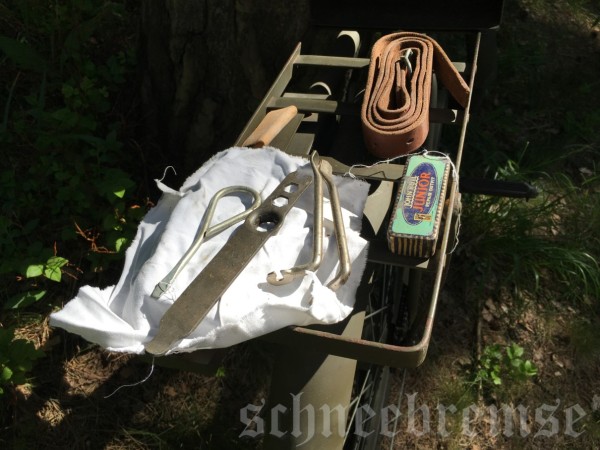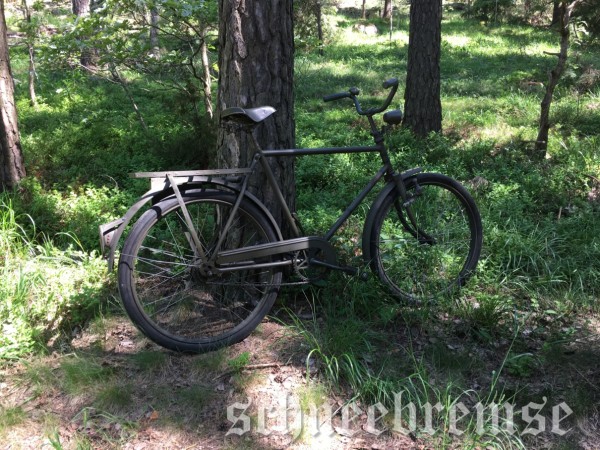Well, to be honest. It is not effective as an attack bicycle, more a excellent and quick transportation on small roads in the forest.
Sweden, as many other country’s have been using bicycles as a effective and quick transportation for the military forces for ages. In Sweden bicycles was mainly mused by the infantry, but bicycles were in all military branches. The air force, the navy as well.
In the army there were dedicated bicycle platoons with all sorts of configurations of bicycles. Some had mounting possibility for hooking up a trailer. There was a medical version for a stretcher being placed between two bicycles (sounds completely dangerous). One version even had a platform mounted on the frame where guard dogs could sit while riding along with the rider.
From the start the Swedish military named the bicycle after the year they were introduced in the service. The first model was m/1901, the m stands for “model” and 1901 the year. After that there was m/1927, m/30, m42, m/104, m/105 and finally m/111. Yes, I know. It is strange that they changed from using the year with four digits as model number to only use two digits and finally end up with a 100 series. Perhaps to confuse the enemy?

Monark made m/105A in it’s natural environment

A previous owner had painted 107 on the toolbox as well as F22 on the front mudguard at some point in time as a joke. F22 was the name of the Swedish air flotilla that was set up in Africa as UN forces between 1961 and 1963
With those old military bicycles comes lots of memories for many of us who did the compulsory military service. During the 20th century every young man (some women to) was drafted to serve about 7-10 months in a military regiment. Infantry, armour, navy, coastal artillery, air force and so on. Every one of these branches had these bicycles, so almost every one have used old bicycles in the classical green colour.
During some transports there used to be something like towing. A line with handles behind a tractor or a lorry where the bicycle riders used to hold on, they were placed in a zigzag pattern. In Sweden that was a common practise for large transportations. Madness, but it worked. Many of the former military service personel gets nostalgic when seeing towing after a tractor, or just by seeing a old military bicycle the memories comes back of the morning roll call, yellow pea soup and pancakes on Thursdays.

Chain wheel and detail of the handle that are mounted on the frame for carrying the bicycle
All those memories. I was told by an elderly family member long ago that when he was did his service during the war he fell asleep while riding his bicycle during a manoeuvre. Suddenly he had fallen out of the ranks and found him self on a field. My father told me that when he was doing his military refresher training back in the late 1960’s being placed in the armoured forces.
One day they as the all were sitting and waiting for something (it was a lot of waiting in the military service). When a tank suddenly rolled up the street where they were. On the middle of the road someone had left a military bicycle. The tank commander in the conning tower noticed the bicycle. The tank rolled over the bicycle, stopped and made a pivot turn (in Swedish it is called a centre turn, meaning the tanks left and right tracks are running opposite each other making the tank turn around its own axis) right above the bicycle.
After the turn was complete, the commander ordered the driver to drive on. On the ground remained the twisted and totally destroyed bicycle. The commander was the famous race driver Picko Troberg.

Military marked (three crowns logo) original tires

Trelleborg T-nabb tires

Toolbox on the luggage rack with the makers name, Monark
When I did my 15 months military service in the navy, we in the staff had military bicycles on the base to move around quickly. I used an old m/42 with leather saddle, wooden handles and a front brake manoeuvred by a large metal bar that was integrated in the handlebars. It was so comfortable to ride that I borrowed it many times when riding to the shop outside the base. We even borrowed the bicycles one summer day when we were “awol” (absent without official leave) and went for a swim in the sea. Packing sandwiches and a towel in our military bags, strapping them on the luggage racks and riding to the beach. The officers were not so happy, but it was a really nice day.

Front light and detail of the spring on the frame that keeps the handlebars straight when being lifted

Even the military needs a bicycle bell. The classic “Pärlan / pearl” design in military green

Details of the protection frame for the rear light and the m/42 design of luggage rack with tool box
In fact I was so pleased with the m/42 bicycle I used in the navy that I a few years later went to a military surplus shop just outside Stockholm and bought an old decommissioned military m/42 bicycle. that still got hay stuck in the hubs. I had it for many years until it was sadly stolen.
Many years later a friend asked me if I wanted his old military bicycle. He thought it was to heavy and clumsy for him to use. I took a look at it and discovered it to be an m/105A version. A later version of the m/42. I realized right away that the rear break was in desperate need of service. The bicycle sounded like an old tram when braking and the rear wheel locked up at the slightest thought of using the rear break. I rode the bicycle home in the night avoiding breaking.
Later that week I dismounted the rear break cleaned the break drum, the break pads, lubricated all the parts that had not been lubricated sin 1972. Mounted it all together and it worked like a charm.

Fichtel & Sachs drum brake model HR 90 V.
The m/105A was made my the bicycle maker Monark in the 60’s, made from surplus parts both from the other bicycle makers Crescent and Husqvarna. I have no idea how many that were made, but since they are almost everywhere it must have been enormous amounts of bicycles in the military services. The advantage with these old bicycles is that parts are available almost anywhere, documents and instructions are easy to find. After all, the kids that were drafted had to do all the service them self, so they needed instructions for it all.

The content of the toolbox, it is all there except the bicycle pump…

…of course marked with three crowns…

…as well as the steering column
Later on I guess more or less all bicycles were decommissioned from their long service. Surplus and traders made the bicycles spread all over Sweden. I remember that the m/42 I bought back in 1992 costed me about £25. They were cheep and sturdy bicycles.
First they where everywhere in the military services, then they where everywhere in the civilian. You can still find them, in apartment bicycle storages, out in bicycle stands in the city. Almost every bicycle shop has one for sale.

With 26″ balloon tires you can ride on any surface and still experience comfort in the saddle
If maintained properly, it is an reliable and great bicycle that can take a lot of abuse.
Only being crushed under a tank might be a problem.